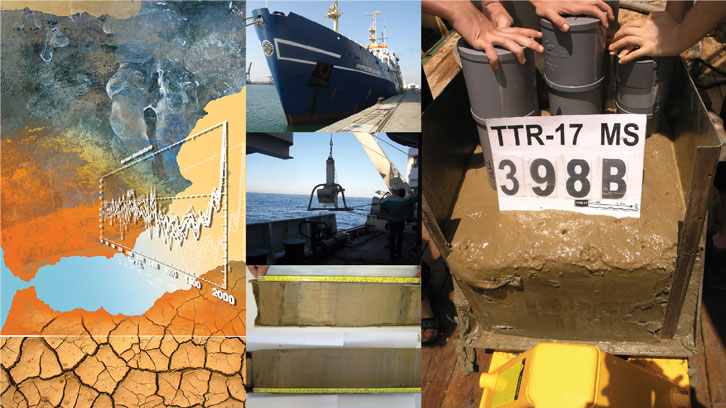Evidence of Natural and Anthropogenic Forcing Over the Past Millennium

Global warming, climate change and their effects on both human health and safety are likely the most severe challenges ever faced by humanity. Recent reports from the Intergovernmental Panel on Climate Change (IPCC 2007, 2014) have provided scientific evidence that globally, the observed increase in average surface temperature since the beginning of the 20th century is probably due to human influence. The global average concentration of carbon dioxide in the atmosphere has increased since the industrial revolution due to human activities and this concentration has now exceeded the range recorded in ice cores over the past 800,000 years. Relatedly, in January 2016, NASA and the U.S. National Oceanic and Atmospheric Administration (NOAA) revealed globally-averaged temperatures in 2015 to be the warmest since modern temperature recording began in 1880.
Surface temperature reconstructions over the past millennium in the Northern Hemisphere indicate warm conditions during the Medieval Climate Anomaly (800-1300 AD) and colder conditions during the Little Ice Age (1300-1850 AD). Climate simulations provide a consistent explanation of this cooling by natural forcing (orbital and solar variability as well as volcanic activity). However, this long-term cooling trend has been reversed during the 20th century. In order to reproduce the warming of the past century in the ocean and on land and fully understand the variability of the Earth system during the 20th century, model simulations must include both human and natural forcing factors.
With this motivation a multidisciplinary international team of researchers from the Biodiversity and Climate Research Centre in Germany (Vanesa Nieto-Moreno), the CSIC in Spain (Francisca Martínez-Ruiz, David Gallego-Torres and Santiago Giralt), the Universitat Autònoma de Barcelona in Spain (Jordi García-Orellana and Pere Masqué), the Royal Netherlands Institute for Sea Research in the Netherlands (Jaap Sinninghe Damsté) and the University of Granada in Spain (Miguel Ortega-Huertas) have undertaken the reconstruction of climate and oceanographic conditions in the Western Mediterranean using marine sediments recovered from the Alboran Sea basin.
The studied region is of particular interest because it is particularly sensitive and vulnerable to climate and anthropogenic forcing due to its semi-enclosed configuration and latitudinal position. For this study we have integrated inorganic and organic geochemical proxies from two marine records, thus inferring variables such as sea surface temperature, humidity, vegetation cover, fluctuations in ocean circulation and the imprint of human activities.
These proxies have evidenced consistent climatic signals in both marine records of warm and mostly dry climate conditions during the Medieval Climate Anomaly changing to humid and cold conditions during the Little Ice Age. The industrial period was characterized by more humid conditions than during the preceding Little Ice Age followed by progressive aridification during the second half of the 20th century. Climate variability seems to be promoted by natural solar forcing and the modulation of the North Atlantic Oscillation (NAO) during the past millennium. The NAO alternates between a ‘‘high-index’’ pattern, characterized by stronger westerlies transporting storms farther into northern Europe. This results in dry winters in the Mediterranean and Northern Africa during the Medieval Climate Anomaly and the second half of the 20th century.
The contrary “low-index” pattern of the NAO causes opposite trends during the Little Ice Age and the industrial period. During prolonged positive modes of the NAO, a weakening of the rate of production of North Atlantic Deep Water and a reduction of upwelling events (up-flow of deep colder and nutrient-richer water) are also shown by our marine records at 1450 and 1950 AD. Anthropogenic contributions have been evidenced by unprecedented rise of temperatures, soil erosion and increasing concentration of pollutants elements since industrial times. Large-scale oceanic-atmospheric circulation patterns (the NAO and the Atlantic meridional circulation) and solar irradiance variations seem to have played a key role during the past millennium. The results indicate natural forcing and anthropogenic contributions determining climate variability in the Western Mediterranean in the more recent record, while the main findings arising from this study have been recently published in a special volume of the Journal of the Geological Society of London (Thematic Set: Holocene Climate Change).
Senckenberg Biodiversity and Climate Research Centre (BiK-F)
Vanesa.Nieto-Moreno@senckenberg.de
Jordi García-Orellana
Pere Masqué
Department of Physics
Institute of Environmental Science and Technology (ICTA)
Jordi.Garcia@uab.cat, Pere.Masque@uab.cat
References
Nieto-Moreno, V.; Martínez-Ruiz, F.; Gallego-Torres, D.; Giralt, S.; García-Orellana, J.; Masqué, P.; Sinninghe Damsté, J.S.; Ortega-Huertas, M. Paleoclimate and paleoceanograhic conditions in the westernmost Mediterranean over the last millennium: an integrated organic and inorganic approach. Journal of the Geological Society. 2015,vol. 172, p. 264-271. doi: 10.1144/jgs2013-105.

